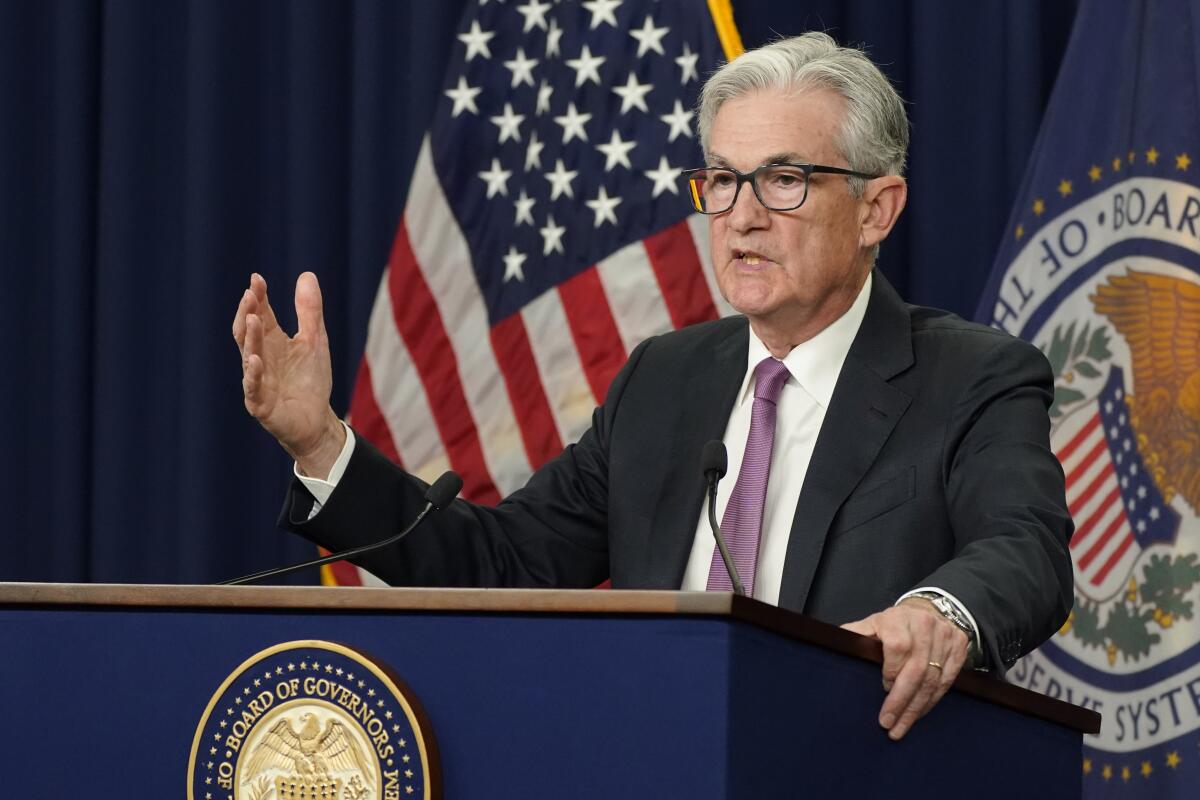Fed could keep lifting interest rates sharply ‘for some time,’ Jerome Powell says

- Share via
JACKSON HOLE, Wyo. — Federal Reserve Chair Jerome H. Powell delivered a stark message Friday: The Fed is likely to impose more large interest rate hikes in coming months and is resolutely focused on taming the highest inflation in four decades.
Powell acknowledged that the Fed’s continued tightening of credit will cause pain for many households and businesses as higher rates further slow the economy and potentially lead to job losses.
“These are the unfortunate costs of reducing inflation,” Powell said in the written version of a high-profile speech he was giving at the Fed’s annual economic symposium in Jackson Hole. “But a failure to restore price stability would mean far greater pain.”
Powell’s message may disappoint investors who were hoping for a signal that the Fed might moderate its rate increases later this year if inflation shows further signs of easing.
After hiking its key short term rate by three-quarters of a point at each of its past two meetings, Powell said the Fed might ease up on that pace “at some point,” suggesting that any such slowing isn’t near.
The Fed chair made clear that he expects rates to remain at levels that should slow the economy “for some time.”
Powell’s remarks kicked off the Fed’s annual economic symposium at Jackson Hole, the first time the conference of central bankers has been held in person since 2019, after it went virtual for two years during the COVID-19 pandemic.
Since March, the Fed has implemented its fastest pace of rate increases in decades to combat inflation, which has punished households with soaring costs for food, gas, rent and other necessities. The central bank has lifted its benchmark rate by 2 full percentage points in just four meetings, to a range of 2.25% to 2.5%.
Those hikes have led to higher costs for mortgages, car loans and other consumer and business borrowing. Home sales have been plunging since the Fed first signaled it would raise borrowing costs.
Powell said last month that the Fed’s aggressive steps had raised its key short-term rate to a point at which it is neither stimulating nor slowing growth. Its benchmark rate had been held near zero from early in the pandemic until this March as the Fed sought to strengthen the economy.
Fed watchers were hoping Powell would send some signal Friday of how large a rate hike the central bank will announce at its next meeting in late September or how long policymakers will keep rates elevated. They also hoped to learn more about what factors the policymakers will consider in the coming months to decide when borrowing rates have gone high enough.
“He’s got to kind of take on the uncertainty about the outlook and try to explain what will they be looking for to make their policy decisions,” said William English, a professor at the Yale School of Management and former senior economist at the Fed.
How far, for instance, must inflation decline before Powell and his colleagues would suspend their rate hikes? What would the Fed do if unemployment, now at a half-century low, began rising? If the economy were to tip into recession, many investors think the Fed might pivot and actually cut rates again. But if inflation isn’t yet under control, that would be unlikely.
In June, Fed policymakers signaled that they expected their key rate to end 2022 in a range of 3.25% to 3.5% and then to rise further next year to between 3.75% and 4%. If rates reached their projected level at the end of this year, they would be at the highest point since 2008. Powell is betting that he can engineer a high-risk outcome: Slow the economy enough to ease inflation pressures yet not so much as to trigger a recession.
His task has been complicated by the economy’s cloudy picture: On Thursday, the government said the economy shrank at a 0.6% annual rate in the April-June period, the second straight quarter of contraction. Yet employers are still hiring rapidly, and the number of people seeking unemployment aid, a measure of layoffs, remains relatively low.
At the same time, inflation is still crushingly high, though it has shown some signs of easing, notably in the form of declining gas prices.
“The data are pretty confusing,” English said. “It’s just hard to know what the exact situation is.”
At its meeting in July, Fed policymakers expressed two competing concerns that highlighted their delicate task.
According to minutes from that meeting, the officials — who aren’t identified by name — have prioritized their inflation fight. Still, some officials said there was a risk that the Fed would raise borrowing costs more than necessary, risking a recession. If inflation were to fall closer to the Fed’s 2% target and the economy weakened further, those diverging views could become hard to reconcile.
After last month’s Fed meeting, Powell told reporters that the size of the next rate hike “would depend on the data we get between now and then.”
He also said that as rates rise, “it likely will become appropriate to slow the pace of increases” and assess how the Fed’s actions have affected the economy. Those remarks helped ignite a stock-market rally because many investors interpreted them to mean the Fed would be less aggressive in the coming months.
Since then, though, many Fed officials have pushed back against any notion that they’re close to easing up on their inflation fight.
More to Read
Sign up for Essential California
The most important California stories and recommendations in your inbox every morning.
You may occasionally receive promotional content from the Los Angeles Times.










